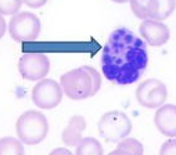Inflammation (Cram)
1/41
There's no tags or description
Looks like no tags are added yet.
Name | Mastery | Learn | Test | Matching | Spaced |
|---|
No study sessions yet.
42 Terms
What type of WBC will show the biggest response to inflammation?
Neutrophils
Term for an increased number of immature neutrophils in the blood
Left shift
What are the three levels of severity of a left shift?
Mild
Moderate
Marked
What level of left shift are bands observed?
Mild
What level of left shift are bands and metamyelocytes observed?
Moderate
What level of left shift are myelocytes and promyelocytes observed?
Marked
What are the two classifications of left shifts?
Regenerative: Good bone marrow response
Degenerative: Poor bone marrow response
In regenerative left shift what kind of neutrophil predominates?
Mature neutrophils
In degenerative left shift what kind of neutrophil predominates?
Immature neutrophils approach or exceed number of mature neutrophils
What are the three disorders that have a left shift?
Leukemoid response
Chronic myeloid leukemia (CML)
Pelger–Huët anomaly (PHA)
Term for an inflammation induced neutrophilia with a left shift so marked that it must be differentiated from leukemia
Leukemoid response
A leukemoid response has a marked left shift back to at least what stage of cell development?
Myelocyte
What condition can cause a leukemoid response?
Pyometra
In what species is Chronic myeloid leukemia primarily seen?
Dogs
Is the WBC count in CML very high or low?
Very high
Does CML have a left shift, if so, how severe?
Marked left shift
What do the nuclei of granulocytes look like with Pulger–Huët anomaly?
Immature shapes (dumbell/peanut) but with mature chromatin
How does an animal get PHA?
Congenital
What are the four classifications of inflammation?
Per acute
Acute
Severe or overwhelming
Chronic
The demand for neutrophils overwhelming and they leave circulation faster than the bone marrow is able to release them. What type of inflammation is this?
Per–acute inflammation
What is the net effect of per–acute inflammation?
Neutropenia
In a short time, the supply of mature neutrophils from the marrow is used up, and increasing numbers of band cells are then released. What type of inflammation is this?
Acute inflammation
What is the net effect of acute inflammation?
Neutrophilia with an increased # of bands (regenerative left shift)
Tissue demand is so great that neutrophils leave the circulation in greater numbers than the bone marrow can keep up with production. What type of inflammation is this?
Severe inflammation
What is the net effect of severe inflammation?
Neutrophilia with increased number of bands (degenerative left shift)
Marrow production of neutrophils establishes a balance with tissue demand for neutrophils. What type of inflammation is this?
Chronic inflammation
What is the net effect of chronic inflammation?
Normal or near normal leukogram
What does the body produce in response to stress or pain?
Glucocorticoids
What is the hallmark for a stress response?
Mild to moderate lymphopenia
What differentiates a stress response from inflammation?
Absence of a left shift with stress response
Is the stress response with dogs or cat more common?
Dogs
What hormone is released during an excitement response?
Epinephrine
What is an excitement response characterized by, especially in dogs?
Neutrophilia
What is an excitement response characterized by, especially in cats and horses?
Lymphocytosis
What is tissue necrosis characterized by?
Monocytosis
What is systemic toxemia characterized by?
Neutrophil toxicity
What are some causes of systemic toxemia?
Bacterial toxin (most common), lead, some drugs, tissue necrosis
What are the three levels of severity of toxic neutrophils?
Mild
Moderate
Severe
Blue cytoplasmic inclusions that can be seen in mild toxic neutrophils
Döehle bodies
Term to describe blue to patchy blue–purple cytoplasm seen in moderate neutrophil toxicity
Cytoplasmic basophilia
What shape can nuclei take on in severe neutrophil toxicity?
Ring–shaped

What is this condition called?
Chediak–Higashi syndrome